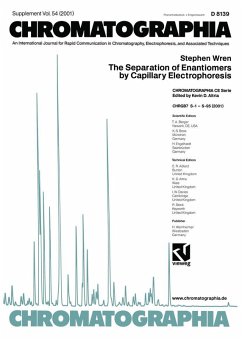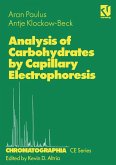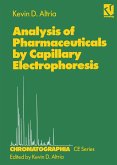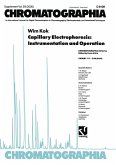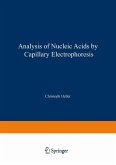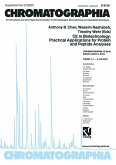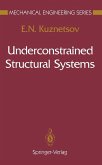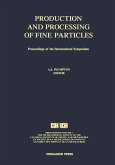Stephen Wren
The Separation of Enantiomers by Capillary Electrophoresis (eBook, PDF)
40,95 €
40,95 €
inkl. MwSt.
Sofort per Download lieferbar

20 °P sammeln
40,95 €
Als Download kaufen

40,95 €
inkl. MwSt.
Sofort per Download lieferbar

20 °P sammeln
Jetzt verschenken
Alle Infos zum eBook verschenken
40,95 €
inkl. MwSt.
Sofort per Download lieferbar
Alle Infos zum eBook verschenken

20 °P sammeln
Stephen Wren
The Separation of Enantiomers by Capillary Electrophoresis (eBook, PDF)
- Format: PDF
- Merkliste
- Auf die Merkliste
- Bewerten Bewerten
- Teilen
- Produkt teilen
- Produkterinnerung
- Produkterinnerung

Bitte loggen Sie sich zunächst in Ihr Kundenkonto ein oder registrieren Sie sich bei
bücher.de, um das eBook-Abo tolino select nutzen zu können.
Hier können Sie sich einloggen
Hier können Sie sich einloggen
Sie sind bereits eingeloggt. Klicken Sie auf 2. tolino select Abo, um fortzufahren.

Bitte loggen Sie sich zunächst in Ihr Kundenkonto ein oder registrieren Sie sich bei bücher.de, um das eBook-Abo tolino select nutzen zu können.
This book gives a comprehensive overview on the principles of physical and mathematical modelling of enantiomer separation by CE. Method development strategies are shown and cyclodextrins as a popular group of chiral selectors as well as some other selectors used as buffer additives for enantiomer separation in free solution are described.
- Geräte: PC
- ohne Kopierschutz
- eBook Hilfe
- Größe: 24.55MB
Andere Kunden interessierten sich auch für
![Analysis of Carbohydrates by Capillary Electrophoresis (eBook, PDF) Analysis of Carbohydrates by Capillary Electrophoresis (eBook, PDF)]() Aran PaulusAnalysis of Carbohydrates by Capillary Electrophoresis (eBook, PDF)40,95 €
Aran PaulusAnalysis of Carbohydrates by Capillary Electrophoresis (eBook, PDF)40,95 €![Analysis of Pharmaceuticals by Capillary Electrophoresis (eBook, PDF) Analysis of Pharmaceuticals by Capillary Electrophoresis (eBook, PDF)]() Kevin D. AltriaAnalysis of Pharmaceuticals by Capillary Electrophoresis (eBook, PDF)73,95 €
Kevin D. AltriaAnalysis of Pharmaceuticals by Capillary Electrophoresis (eBook, PDF)73,95 €![Capillary Electrophoresis: Instrumentation and Operation (eBook, PDF) Capillary Electrophoresis: Instrumentation and Operation (eBook, PDF)]() Wim KokCapillary Electrophoresis: Instrumentation and Operation (eBook, PDF)40,95 €
Wim KokCapillary Electrophoresis: Instrumentation and Operation (eBook, PDF)40,95 €![Analysis of Nucleic Acids by Capillary Electrophoresis (eBook, PDF) Analysis of Nucleic Acids by Capillary Electrophoresis (eBook, PDF)]() Analysis of Nucleic Acids by Capillary Electrophoresis (eBook, PDF)73,95 €
Analysis of Nucleic Acids by Capillary Electrophoresis (eBook, PDF)73,95 €![CE in Biotechnology: Practical Applications for Protein and Peptide Analyses (eBook, PDF) CE in Biotechnology: Practical Applications for Protein and Peptide Analyses (eBook, PDF)]() CE in Biotechnology: Practical Applications for Protein and Peptide Analyses (eBook, PDF)40,95 €
CE in Biotechnology: Practical Applications for Protein and Peptide Analyses (eBook, PDF)40,95 €![Underconstrained Structural Systems (eBook, PDF) Underconstrained Structural Systems (eBook, PDF)]() E. N. KuznetsovUnderconstrained Structural Systems (eBook, PDF)73,95 €
E. N. KuznetsovUnderconstrained Structural Systems (eBook, PDF)73,95 €![Production and Processing of Fine Particles (eBook, PDF) Production and Processing of Fine Particles (eBook, PDF)]() Production and Processing of Fine Particles (eBook, PDF)52,95 €
Production and Processing of Fine Particles (eBook, PDF)52,95 €-
-
- -21%11
This book gives a comprehensive overview on the principles of physical and mathematical modelling of enantiomer separation by CE. Method development strategies are shown and cyclodextrins as a popular group of chiral selectors as well as some other selectors used as buffer additives for enantiomer separation in free solution are described.
Dieser Download kann aus rechtlichen Gründen nur mit Rechnungsadresse in A, B, BG, CY, CZ, D, DK, EW, E, FIN, F, GR, HR, H, IRL, I, LT, L, LR, M, NL, PL, P, R, S, SLO, SK ausgeliefert werden.
Produktdetails
- Produktdetails
- Verlag: Vieweg+Teubner Verlag
- Seitenzahl: 95
- Erscheinungstermin: 17. April 2013
- Englisch
- ISBN-13: 9783322831415
- Artikelnr.: 53135937
- Verlag: Vieweg+Teubner Verlag
- Seitenzahl: 95
- Erscheinungstermin: 17. April 2013
- Englisch
- ISBN-13: 9783322831415
- Artikelnr.: 53135937
- Herstellerkennzeichnung Die Herstellerinformationen sind derzeit nicht verfügbar.
The author is a development scientist in pharmaceutical and analytical research and development at AstraZeneca in Macclesfield. He has a general interest in separation science and has been active for a number of years in the field of research into the principles and application capillary electrophoresis in pharmaceutical analysis.
Supplement Vol. 54, 2001.- 1 Enantiomers and Separation.- 1.1 Introduction.- 1.2 Enantiomers and Living Organisms.- 1.3 The Separation of Enantiomers.- 1.4 Electrophoretic Separation of Enantiomers.- 1.5 Enantiomer Separations by Capillary Electrophoresis.- 1.6 Conclusion.- 2 The Principles of Separation in CE.- 2.1 Introduction: Movement and Separation.- 2.2 Separative and Non-Separative Transport in CE.- 2.3 Electrophoretic Mobility.- 2.4 Electroosmotic Mobility.- 2.5 CE Instrumentation.- 2.6 Conclusion.- 3 Modelling Enantiomer Separation by CE.- 3.1 The Use of Models.- 3.2 Background.- 3.3 The Physical Model.- 3.4 A Basic Mathematical Model.- 3.5 Extended Theoretical Models.- 3.6 Conclusion.- 4 Method Development Strategies.- 4.1 The Purpose of the Method.- 4.2 Factors Controlling Resolution.- 4.3 The Structure of the Analyte.- 4.4 The Choice of Chiral Selector.- 4.5 Other Separation Conditions.- 4.6 Optimisation Approaches.- 4.7 Validation.- 4.8 Computer Simulations.- 4.9 Conclusion.- 5 The Use of Cyclodextrins as Chiral Selectors.- 5.1 Introduction.- 5.2 Structure and Properties.- 5.3 Cyclodextrin Production.- 5.4 Complexation Mechanisms.- 5.5 Cyclodextrin Classes.- 5.6 Analyte Classes.- 5.7 Analyte Structure.- 5.8 Batch and Source Variation.- 5.9 Conclusion.- 6 Other Chiral Selectors.- 6.1 Introduction.- 6.2 Ligand Exchange Selectors.- 6.3 Chiral Surfactants.- 6.4 Alkaloids.- 6.5 Crown Ethers.- 6.6 Natural Macromolecules.- 6.7 Non-Aqueous CE.- 6.8 Derivatisation.- 6.9 Capillary Electrochromatography.- 6.10 Conclusion.
Supplement Vol. 54, 2001.- 1 Enantiomers and Separation.- 1.1 Introduction.- 1.2 Enantiomers and Living Organisms.- 1.3 The Separation of Enantiomers.- 1.4 Electrophoretic Separation of Enantiomers.- 1.5 Enantiomer Separations by Capillary Electrophoresis.- 1.6 Conclusion.- 2 The Principles of Separation in CE.- 2.1 Introduction: Movement and Separation.- 2.2 Separative and Non-Separative Transport in CE.- 2.3 Electrophoretic Mobility.- 2.4 Electroosmotic Mobility.- 2.5 CE Instrumentation.- 2.6 Conclusion.- 3 Modelling Enantiomer Separation by CE.- 3.1 The Use of Models.- 3.2 Background.- 3.3 The Physical Model.- 3.4 A Basic Mathematical Model.- 3.5 Extended Theoretical Models.- 3.6 Conclusion.- 4 Method Development Strategies.- 4.1 The Purpose of the Method.- 4.2 Factors Controlling Resolution.- 4.3 The Structure of the Analyte.- 4.4 The Choice of Chiral Selector.- 4.5 Other Separation Conditions.- 4.6 Optimisation Approaches.- 4.7 Validation.- 4.8 Computer Simulations.- 4.9 Conclusion.- 5 The Use of Cyclodextrins as Chiral Selectors.- 5.1 Introduction.- 5.2 Structure and Properties.- 5.3 Cyclodextrin Production.- 5.4 Complexation Mechanisms.- 5.5 Cyclodextrin Classes.- 5.6 Analyte Classes.- 5.7 Analyte Structure.- 5.8 Batch and Source Variation.- 5.9 Conclusion.- 6 Other Chiral Selectors.- 6.1 Introduction.- 6.2 Ligand Exchange Selectors.- 6.3 Chiral Surfactants.- 6.4 Alkaloids.- 6.5 Crown Ethers.- 6.6 Natural Macromolecules.- 6.7 Non-Aqueous CE.- 6.8 Derivatisation.- 6.9 Capillary Electrochromatography.- 6.10 Conclusion.
